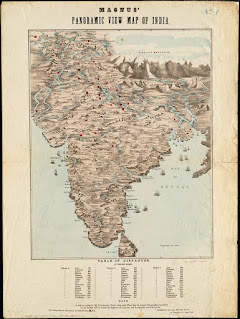Geographical background of Indian History : The vast peninsula of the Asian continent lying south of the Himalayas and north of the Indian Ocean is called India. Its vast landmass, called a subcontinent, resembles an odd quadrilateral in shape. It is about 2500 miles long and 2000 miles wide. It is equal in extent to all of Europe except Russia. The Greeks called the country India, and medieval writers referred to it as Hind or Hindustan. Geographically, it can be divided into four divisions:
(1) Mountainous region of the North - It extends from the swamp forests of the Terai to the peak of the Himalayas, which includes the states of Kashmir, Kangra, Tehri, Kumaon and Sikkim.
(2) Northern plains of Ganga and Indus: This region includes the valleys of Indus and its tributaries, the desert parts of Sindh and Rajasthan and the regions irrigated by Ganga and Yamuna. This part of the country is the most fertile. Aryan culture developed here. This is called Aryavarta.
(3) Southern Plateau – This region includes the area between Narmada in the north and Krishna and Tungabhadra in the south.
(4) Plains of the far south: This includes the long and narrow sea areas of the south. This part includes the fertile delta regions of Godavari, Krishna and Kaveri rivers.
The plateau in the south and the regions in the far south together form modern South India. The Narmada and Tapti rivers, the Vindhya and Satpura hills, and the forests of Mahakantar together separate North India from South India. As a result of this separation, South India remained free from the influence of Aryan culture, while Aryan culture flourished in North India. An entirely different culture developed in South India called 'Dravidian'. Remnants of this culture still exist in the south.
Historical Geography of India UPSC
Nature has endowed India with a distinct geographical unit. In the north, the Himalayas protect it like a high wall, and the Indian Ocean surrounds the country from the east, west, and south. Being largely protected from external invasions by these natural resources, India has been able to build a completely independent and separate civilization of its own.
The geography here has had a profound impact on Indian history. Each region here has its own unique story. There are high mountains on one side and low plains on the other, extremely fertile regions on one side and vast deserts on the other. There are raised plateaus, dense forests, and secluded valleys. At the same time, some places are extremely hot and some are extremely cold.
Geographical specialty:
Each geographical region of India has developed as a distinct unit and has maintained its uniqueness for centuries. Racial and linguistic elements have also been responsible for this uniqueness. As a result, it has never been possible to establish political unity in the entire country, although attempts have been made by great rulers at many times.
The history of ancient India is, in a way, the story of a continuous struggle between the tendencies of centralization and decentralization. The vastness of the country and its isolation from the rest of the world has produced many important consequences. Due to India being a distinct geographical entity in itself, Indian rulers and generals never made any effort to expand their empire outside the country or to fulfill their military ambitions, rather they expanded their empire in India itself.
The example of the Cholas of the far south can be considered an exception in this matter. Since ancient times, people of different castes, languages, religions, clothes and customs have lived here. The differences here may surprise any outside observer.
Unity in diversity :
But there appears to be a unity among these external variations which no one can ignore. As a result, "unity in diversity" has become the overriding feature of Indian culture. The common natural boundaries of the country have awakened the spirit of common motherland in the minds of the residents here. The idea of fundamental unity always prevailed here and influenced the political ideals of the country. Although little political unity was established in practice, it can be seen in every era of history as a political principle.
Cultural unity :
Cultural unity has been more pronounced. Language, literature, social and religious ideals have been the principal means of this unity. We have had visions of this fundamental unity since the earliest times of Indian history. In the epics and Puranas, the entire country is referred to as "Bharatavarsha," that is, the country of Bharata, and its inhabitants as "Bharati" (children of Bharata). This unity is clearly expressed in the Vishnu Purana: "That which lies to the north of the sea and to the south of the Himalayas is the country of Bharat." And the children there are 'Bharati'. "
This feeling of unity has been present in the minds of ancient poets, writers and thinkers since centuries. It is said in Kautilya Arthashastra that "The area extending a thousand yojanas from the Himalayas to the sea is the ruling area of the Chakravarti king." This concept of the Sovereign Emperor has been inspiring Indian emperors since ancient times.
This essential unity is also reflected in the ancient religious sentiments and beliefs of Indians. Here seven holy rivers - Ganga, Yamuna, Godavari, Saraswati, Narmada, Indus and Kaveri, seven mountains - Mahendra, Malay, Sahya, Shuktiman, Rikshya, Vindhya and Pariatra and seven cities - Ayodhya, Mathura, Maya, Kashi, Kanchi, 'Avanti, Puri and Dwaravati', despite being situated in different parts of the country, have been equally revered by all the residents of the country.
Texts like Vedas, Puranas, Upanishads, Ramayana, Mahabharata etc. are respected everywhere and gods like Shiva and Vishnu are worshiped everywhere.
Although there are many languages, they all originate or are influenced by Sanskrit.The social system propounded by the Dharmashastras is also the same everywhere. Varnashrama, Purushartha, etc. have been the ideals of all societies. In ancient times, when means of transport were scarce, tourists, preachers, pilgrims, students, etc. have been instrumental in establishing this unity. The emperors aspiring to the position of Chakravartin have always expressed the feeling that the vast territory of India is one, through the rituals of Rajasuya, Ashwamedha, etc.
Thus, the essential unity in diversity remains the most prominent feature of Indian culture. "
Geographical background of Indian History
Mains Question : Explain the role of geographical factors towards the development of Ancient India. (UPSC GS.1 2023)
Ans :
Geography played an important role in shaping the development of ancient India. Rivers, mountains, trade routes, forests, passes, and the monsoon all played important parts.
Rivers
Rivers were central to the establishment of civilizations and empires in ancient India. The Harappan Civilization was based on the river Indus and its tributaries and the Vedic one on the rivers of punjab and in the Ganges-Yamuna river system.
The fertile plains of the Ganges River System led to a surplus of agriculture, which spurred social, political, and economic developments.
Mountains
Mountain ranges, such as the Himalayas, acted as natural barriers for foreign invasions and cultural divides. The Vindhyas was a natural cultural division between the North and South.
Trade Routes
Land and sea trade routes facilitated economic and cultural contacts between different regions of India and the world.
The oceans connected the ports, influencing trade and economic, cultural, and political contacts. These land and sea routes also paved the way for the spread of various ideas, philosophies, and religions. For example, Buddhism spread through the Silk Routes to Central Asia and China, and to Sri Lanka and Southeast Asia through sea trade routes.
Forests
Forests provided vast timber, which was used in the construction of palaces and other structures, contributing to political growth.
Passes
Important passes through the Himalayas and Hindu Kush mountains facilitated interaction with western, central, and northern Asia. These passes also facilitated foreign invasions into India, especially from the northwest.
Monsoon
The monsoon helped in establishing trade relations with Arabs and the Graeco-Romans, which in turn helped in developing cultural relations.
Conclusion
The Indian subcontinent, with its well-defined natural barriers, exemplifies how geography influenced the evolution of this ancient civilization. Rivers, mountains, trade routes, forests, passes, and the monsoon all played important parts in shaping the development of ancient India.







